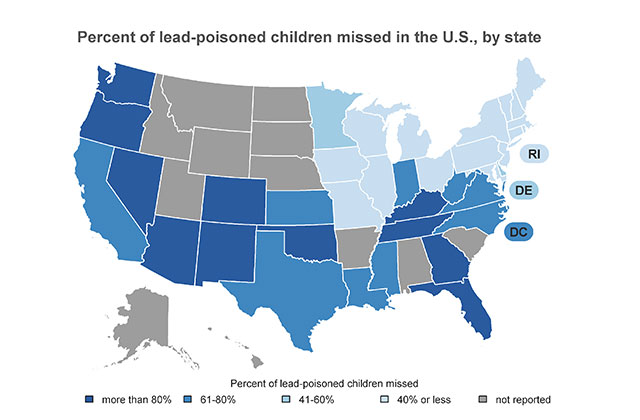A study published today (April 27) in the peer-reviewed journal Pediatrics shows what lead poisoning among U.S. children looks like—and it’s bad.
Roughly a third of children exposed to lead likely go undiagnosed, according to the study. The study looked at 39 states where data is available from 1999 to 2010. Only 607,000 of the 944,000 cases in states that report to the Centers for Disease Control Control and Prevention (CDC) are identified. That means 36 percent of cases go unnoticed.
Lead poisoning is extremely dangerous for children, so much so that the CDC has determined no amount of lead safe is for them. The toxic metal can damage the brain and nervous system, slowing a child’s growth and development, which can lead to learning and behavioral problems.
The lead author of the study, Eric Roberts, who serves as a co-principal investigator at the Public Health Institute’s California Environmental Health Tracking Program, expressed concern over these numbers in a press release—particularly because lead poisoning is preventable.
“Now we know that many more children who have been exposed to lead are not tested, not counted and not treated,” Roberts said. “Without the true numbers, we can’t help the children who have been poisoned, or root out how and why so many children are being poisoned in the first place.”
While underreporting is true across the U.S., it is most severe in the South and West. While the reported number of lead-poisoned children is higher in the Northeast and Midwest, the number of actual cases is highest in the South.*
The most high-profile case of lead poisoning in children is the ongoing water crisis in Flint, Michigan. April 25 marked the three-year anniversary of when city officials switched their water source, which partially led to lead entering Flint’s drinking water system. Residents still rely on bottled or filtered water for their daily needs like cooking and washing.
But lead poisoning—and water contamination overall—is pervading communities around the United States, especially those whose residents are predominantly of color. Other studies have, like one the CDC published in 2009 that found Black and Mexican-American children suffer from lead poisoning at higher rates than their White counterparts. That’s 11.2 percent of Black children and 4 percent of Mexican-American children, with only 2.3 percent of White children.
Find the complete study here.
*This post has been clarified to note that the number of childhood lead poisoning cases is highest in the South, not the Northeast and Midwest though their reported numbers are highest.
